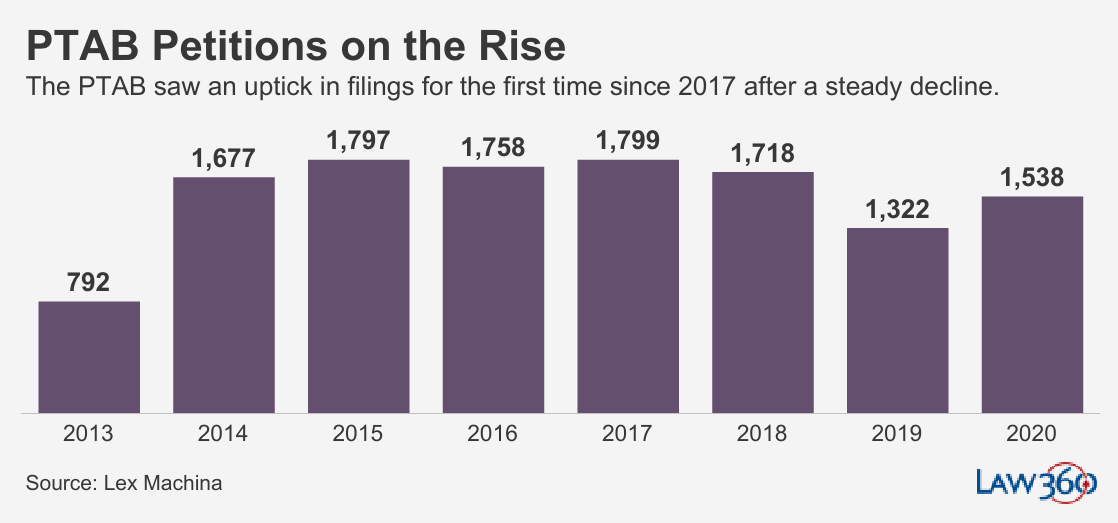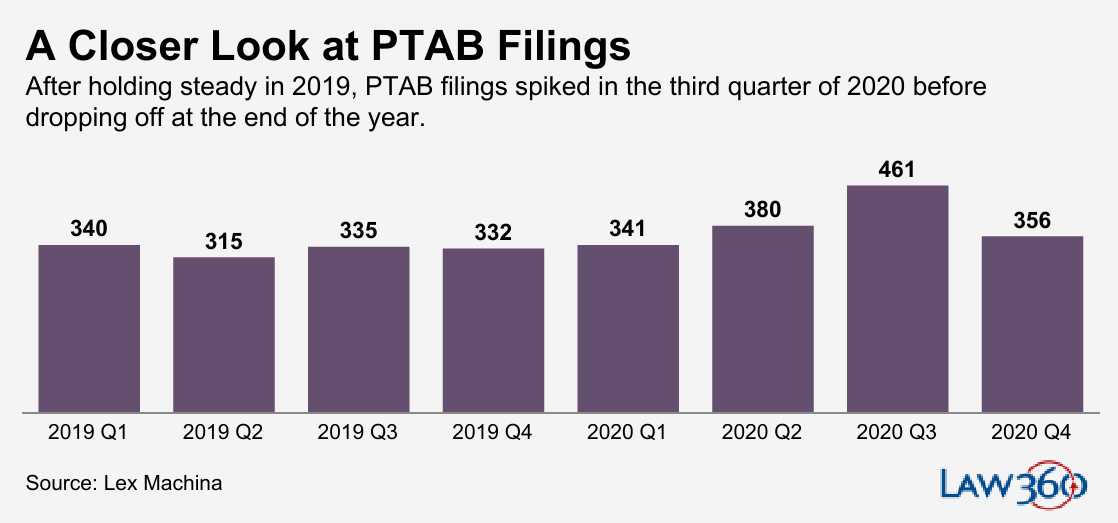By Britain Eakin
Law360 (March 10, 2021, 11:05 PM EST) — The Patent Trial and Appeal Board saw a rise in petitions in 2020 for the first time since 2017, hitting a level that attorneys think may hold steady.
Patent challengers filed 1,538 petitions of all types last year, a 16% increase from the 1,322 petitions filed in 2019, according to a new report from Lex Machina. While PTAB cases rose for the first time in three years, the 2020 total still fell several hundred shy of 2017’s high of 1,799 petitions filed.
The 2020 increase in PTAB filings might be partly attributable to the slowdown of infringement trials in district court due to the coronavirus pandemic. Since the PTAB transitioned seamlessly to a remote format, Lex Machina said that might have drawn more cases there.
Trenton Ward, a partner with Finnegan Henderson Farabow Garrett & Dunner LLP and a former lead administrative patent judge at the PTAB, agreed that could partly explain the rise in filings.
“I think they did a great job of keeping cases on track. And since almost every other tribunal was impacted somehow, and many are still not back on schedule, it has probably made the PTAB a more attractive venue,” Ward said.
In 2019, PTAB filings fell off sharply, dropping 23% to 1,322 from 1,718 the year before. Attorneys at the time attributed the decrease to a reduction in district court infringement suits and policies the board adopted that discouraged patent challengers from filing multiple petitions.
But Ward said the low filing number in 2019 was likely an anomaly given that the case numbers were so much higher in the preceding five years. From 2014 through 2018, filings ranged from 1,677 on the low end to 1,799 on the high end. Ward said 2020’s numbers might be indicative of what’s to come.
“I think that what we saw for 2020 is more akin to what we will see going forward in the future — 1,500 to 1,600 will be the relative plateau moving forward,” he said.
Michael D. Specht, co-chair of the PTAB practice at Sterne Kessler Goldstein & Fox PLLC, told Law360 the jump in case filings is noteworthy.
“The fact that there are still a lot of filings is the significant news. It shows that the PTAB remains a really important piece of the litigation landscape,” he said.
Specht also said the low number in 2019 was likely an anomaly, but had a different explanation for it. The board’s adoption in November 2018 of the claim construction standard used by district courts might have led to a surge in filings at the end of that year, he said.
That likely padded 2018’s total and siphoned off a number of petitions that would have otherwise been filed in 2019. Without the new claim construction standard, Specht said that PTAB filings might have looked more evenly distributed over 2018 and 2019.
But there was a curveball in 2020 that might have also boosted PTAB filings: the board’s precedential decision in Apple Inc. v. Fintiv Inc. The decision laid out six factors for the board to consider in weighing whether the advanced stage of parallel district court litigation favors denying a patent review.
The board decided Fintiv on March 20, 2020, and designated it as precedential on May 5. According to Lex Machina, PTAB filings ticked up in the second quarter of fiscal year 2020 immediately after Fintiv came down, and they spiked in the third quarter after the board made it precedential. Filings then dropped off sharply in the fourth quarter.
According to David L. Holt, a principal at Fish & Richardson PC, Fintiv might have partly driven the uptick in case filings last year. Defendants in district court cases that were further along in the one-year window for filing at the board had to jump after Fintiv, and in general, he said the ruling will continue to force petitioners to decide more quickly whether to go to the PTAB.
“I think the exacerbated uptick right after Fintiv likely had to do with everybody recognizing, ‘Wait a second, if we’re late in our window, we have to file real quick now if we want to have any chance of having our IPRs considered,’” Holt said.
The assessments from the attorneys are largely on point, according to Texas A&M University School of Law professor Saurabh Vishnubhakat, who has focused much of his academic research on the PTAB.
While he said it’s reasonable to assess that the uptick in PTAB filings in 2020 may show that IPR filings are evening out, he suggested there’s a caveat given that 70% of IPR petitions are filed by defendants in district court litigation.
“This means IPR filings are a lagging indicator of district court infringement filings,” Vishnubhakat said. “And as district court infringement filings change, we should expect to see corresponding changes in IPR filings as well.”
–Editing by Bruce Goldman.
Law360 is owned by LexisNexis Legal & Professional, a RELX company, which owns Lex Machina.
Related Professionals

Receive insights from the most respected practitioners of IP law, straight to your inbox.
Subscribe for Updates

